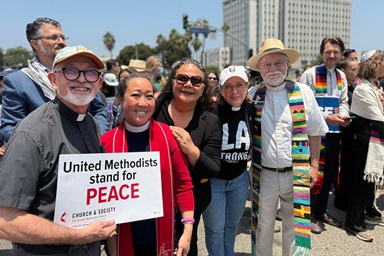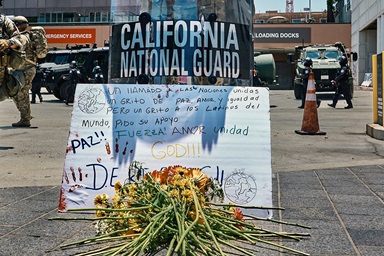I first saw the wall at a distance while on a trip to the border. I asked myself, “Why the wall”? Not only does it cause a divide, it marks a separation between two nations, and imposes limits and gut wrenchingly breaks up families, it breaks up the landscape. “It makes no sense,” I said to myself. If we share the same sky, sun and stars. Why build this wall?”
The wall is the one that separates the United States and México at one of the major border towns between Tijuana and San Ysidro, south of San Diego.
On Wednesday, August 6, 2014, several members of the United Methodist Church attending the annual assembly of MARCHA (Methodists Associated Representing the Cause of Hispanic Americans) set out from El Segundo, California and traveled to Tijuana to experience the border reality.
Facing the wall on the Mexican side, I recalled my trip to Jerusalem in 1998 and the visit to the Wailing Wall. Both experiences were significant for me. In front of both walls I prayed, cried and reflected. Even though I experienced similar emotions at both sites, I had not realized the similarities until Reverend Saúl Montiel referred to it as the “Wailing Wall.”
The Rev. Montiel, an ordained elder in the United Methodist Church, and currently pastor of a congregation in San Diego, led the group on the tour along the border. As we approached the wall, he led us to a place called Friendship Park. At this location there is thick mesh embedded within the tall steel wall. Though contact is severely restricted, people are still able to see one another across the wall. Montiel explained that on Saturdays and Sundays, from 10 a.m. to 2 p.m., people are allowed to meet at the wall for 30 minutes in groups of 25 at a time to visit with family members on the opposite side. Montiel bears witness to the heartbreaking cries of family members who, in many cases, have not seen each other for many years. Mothers, fathers, sons, daughters, siblings and friends are reunited and though they cannot embrace, at least they can see each other. This is why Montiel calls it the Wailing Wall. This explanation helped me see the similarities in the border wall and the wall in Jerusalem. At the same time, I noted the differences.
The Jerusalem Wailing Wall lies in ruins at the base of the Temple. That building represented the very presence of God for the people. The U.S.-Mexico border wall, on the other hand, was built to impose separation, inflict injustice and oppression manifested in the abuse it perpetuates against the dignity of millions of suffering people.
There, standing in front of the wall, we celebrated a communion service. I placed my hands on the wall. I was moved by the cries of my brothers and sisters as we all prayed for the day when the wall will be removed. I felt like circling the wall seven times and on the final turn blow the ram’s horn, give a mighty shout and watch the wall come down, like the walls at Jericho.
I recalled the biblical passage of Nehemiah’s inspection of the walls of Jerusalem that had been broken down and its gates destroyed by fire. But in this case, unlike in Nehemiah’s story, I would be filled with joy to inspect the border wall between the United States and Mexico and find it broken down and consumed by fire.
Berrios is associate web developer for Upper Room Ministries.
News media contact: Vicki Brown, Nashville, Tenn., (615) 742-5470 or [email protected].
Like what you're reading? Support the ministry of UM News! Your support ensures the latest denominational news, dynamic stories and informative articles will continue to connect our global community. Make a tax-deductible donation at ResourceUMC.org/GiveUMCom.




